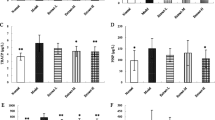Abstract
Background
Histamine regulates function of osteoclasts and osteoblasts, however data regarding the influence of histamine H2 receptors antagonists on bone tissue are ambiguous. Factors that influence growing skeleton may have an important impact on the peak bone mass and future risk of fractures. The aim of our study was the assessment of influence of ranitidine, on growing bones.
Methods
The experiment was carried out on young male Wistar rats divided into two groups receiving either ranitidine (10 mg/kg ip) or vehicle.
Results
A significant decrease in femoral BMD in ranitidine-treated rats (R) compared to vehicle-treated ones (C) was detected (0.262 ± 0.009 g/cm2vs. 0.271 ±0.007 g/cm2, p < 0.05). In group R we observed elevated serum C-terminated telopeptide of type I collagen (CTX) level with concomitantly lowered serum osteocalcin (OC) concentration comparing to control group (151.2 ± 27.2 pg/ml vs. 101.5 ± 55.6, p < 0.05 and 229.1 ± 50.0 pg/ml vs. 292.0 ± 52.9, p < 0.05, respectively). Serum concentration of inorganic phosphorus was lower in group R than in group C (134 ± 13 mmol/L vs. 157 ± 28 mmol/L, p < 0.05).
Conclusions
Long-term administration of ranitidine increases bone resorption and decreases bone formation in growing rats leading to decrease in BMD.
Similar content being viewed by others
References
World Health Organization. Assessment of fracture risk and its application to screening for postmenopausal osteoporosis. Report of a WHO Study Group. World Health Organ Tech Rep Ser 1994;843:1–129.
Johnell O. The Socioeconomic Burden of Fractures: today and in the 21 st Century. Am J Med 1997;103:20S–5S, doi:https://doi.org/10.1016/S0002-9343(97)90023-1.
Ikawa Y, Yonekawa T, Ohkuni Y, Kuribayashi M, Fukino K, Ueno K. A comparative study of histamine activities on differentiation of osteoblasts and osteoclasts. J Toxicol Sci 2007;32:555–64, doi:https://doi.org/10.2131/jts.32.555.
Longhini R, de Oliveira PA, de Souza Faloni AP, Sasso-Cerri E, Cerri PS. Increased apoptosis in osteoclasts and decreased RANKL immunoexpression in periodontium of cimetidine-treated rats. J Anat 2013;222:239–47, doi:https://doi.org/10.1111/joa.12011.
Deyama Y, Kikuiri T, Ohnishi GI, Feng YG, Takeyama S, Hatta M, et al. Histamine stimulates production of osteoclast differentiation factor/receptor activator of nuclear factor-kappaB ligand by osteoblasts. Biochem Biophys Res Commun 2002;298:240–6, doi:https://doi.org/10.1016/S0006-291X(02)02440-3.
Ezzat BA, Abbass MMS. The ability of H1 or H2 receptor antagonists or their combination in counteracting the glucocorticoid-induced alveolar bone loss in rats. J Oral Pathol Med 2014;43:148–56, doi:https://doi.org/10.1111/jop.12104.
Biosse-Duplan M, Baroukh B, Dy M, de Vernejoul M-C, Saffar J-L. Histamine promotes osteoclastogenesis through the differential expression of histamine receptors on osteoclasts and osteoblasts. Am J Pathol 2009;174:1426–34, doi:https://doi.org/10.2353/ajpath.2009.080871.
Williams GA, Longley RS, Bowser EN, Hargis GK, Kukreja SC, Vora NM, et al. Parathyroid hormone secretion in normal man and in primary hyperparathyroidism: role of histamine H2 receptors. J Clin Endocrinol Metab 1981;52:122–7.
Wagner PK, Krause U, Scharfe T, Beyer J, Rothmund M. Effect of cimetidine on basal and histamine-induced secretion of parathyroid hormone in vitro. Nephron 1984;36:89–93.
Solomon DH, Diem SJ, Ruppert K, Lian Yin J, Liu CC, Wohlfart A, et al. Bone mineral density changes among women initiating proton pump inhibitors or H2 receptor antagonists: a SWAN cohort study. J Bone Min Res 2015;30:232–9, doi:https://doi.org/10.1002/jbmr.2344.
Corley DA, Kubo A, Zhao W, Quesenberry C. Proton pump inhibitors and histamine-2 receptor antagonists are associated with hip fractures among at-risk patients. Gastroenterology 2010;139:93–101, doi:https://doi.org/10.1053/j.gastro.2010.03.055.
Folwarczna J, Śliwiński L, Pytlik M, Janas A. Effects of histamine H1, H2 and H3 receptor antagonists on bone mechanical properties in female rats. Bone 2011;48:S193.
Folwarczna J, Janas A, Pytlik M, Śliwiński L, Wiercigroch M, Brzęczek A. Modifications of histamine receptor signaling affect bone mechanical properties in rats. Pharmacol Rep 2014;66:93–9, doi:https://doi.org/10.1016/j.pharep.2013.08.010.
Lesclous P, Guez D, Baroukh B, Vignery A, Saffar JL. Histamine participates in the early phase of trabecular bone loss in ovariectomized rats. Bone 2004;34:91–9, doi:https://doi.org/10.1016/j.bone.2003.08.007.
Lesclous P, Schramm F, Gallina S, Baroukh B, Guez D, Saffar JL. Histamine mediates osteoclastic resorption only during the acute phase of bone loss in ovariectomized rats. Exp Physiol 2006;91:561–70, doi:https://doi.org/10.1113/expphysiol.2006.033217.
Lesclous P, Guez D, Saffar JL. Short-term prevention of osteoclastic resorption and osteopenia in ovariectomized rats treated with the H2 receptor antagonist cimetidine. Bone 2002;30:131–6, doi:https://doi.org/10.1016/S8756-3282(01)00629-9.
Dobigny C, Saffar JL. H1 and H2 histamine receptors modulate osteoclastic resorption by different pathways: evidence obtained by using receptor antagonists in a rat synchronized resorption model. J Cell Physiol 1997;173:10–8, doi:https://doi.org/10.1002/(SICI)1097-4652(199710)173:1<10:AID-JCP2>3.0.CO;2-M.
Yamaura K, Yonekawa T, Nakamura T, Yano S, Ueno K. The histamine H-2-receptor antagonist, cimetidine, inhibits the articular osteopenia in rats with adjuvant-induced arthritis by suppressing the osteoclast differentiation induced by histamine. J Pharmacol Sci 2003;92:43–9.
Longhini R, Aparecida de Oliveira P, Sasso-Cerri E, Cerri PS. Cimetidine reduces the alveolar bone loss in induced periodontitis in rat molars. J Periodontol 2016;2013:1115–25, doi:https://doi.org/10.1902/jop.2013.130453.
Kopic S, Geibel JP. Gastric acid, calcium absorption, and their impact on bone health. Physiol Rev 2013;93:189–268, doi:https://doi.org/10.1152/physrev.00015.2012.
Author information
Authors and Affiliations
Corresponding author
Rights and permissions
About this article
Cite this article
Matuszewska, A., Nowak, B., Jędrzejuk, D. et al. Effect of long-term administration of ranitidine, a histamine H2 receptor antagonist, on bone metabolism in young growing rats. Pharmacol. Rep 70, 951–954 (2018). https://doi.org/10.1016/j.pharep.2018.03.005
Received:
Revised:
Accepted:
Published:
Issue Date:
DOI: https://doi.org/10.1016/j.pharep.2018.03.005




